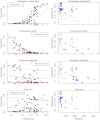Species distributions in response to individual soil nutrients and seasonal drought across a community of tropical trees
- PMID: 23440213
- PMCID: PMC3612601
- DOI: 10.1073/pnas.1218042110
Species distributions in response to individual soil nutrients and seasonal drought across a community of tropical trees
Abstract
Tropical forest vegetation is shaped by climate and by soil, but understanding how the distributions of individual tree species respond to specific resources has been hindered by high diversity and consequent rarity. To study species over an entire community, we surveyed trees and measured soil chemistry across climatic and geological gradients in central Panama and then used a unique hierarchical model of species occurrence as a function of rainfall and soil chemistry to circumvent analytical difficulties posed by rare species. The results are a quantitative assessment of the responses of 550 tree species to eight environmental factors, providing a measure of the importance of each factor across the entire tree community. Dry-season intensity and soil phosphorus were the strongest predictors, each affecting the distribution of more than half of the species. Although we anticipated clear-cut responses to dry-season intensity, the finding that many species have pronounced associations with either high or low phosphorus reveals a previously unquantified role for this nutrient in limiting tropical tree distributions. The results provide the data necessary for understanding distributional limits of tree species and predicting future changes in forest composition.
Conflict of interest statement
The authors declare no conflict of interest.
Figures



Comment in
-
Multiple dimensions of resource limitation in tropical forests.Proc Natl Acad Sci U S A. 2013 Mar 26;110(13):4864-5. doi: 10.1073/pnas.1301606110. Epub 2013 Mar 8. Proc Natl Acad Sci U S A. 2013. PMID: 23476063 Free PMC article. No abstract available.
References
-
- Condit R, Hubbell SP, Foster RB. Mortality rates of 205 neotropical tree and shrub species and the impact of a severe drought. Ecol Monogr. 1995;65(4):419–429.
-
- Leigh EG. Tropical Forest Ecology: A View from Barro Colorado Island. New York: Oxford Univ Press; 1999.
-
- Wright SJ. Plant diversity in tropical forests: A review of mechanisms of species coexistence. Oecologia. 2002;130(1):1–14. - PubMed
-
- Condit R, et al. The importance of demographic niches to tree diversity. Science. 2006;313(5783):98–101. - PubMed
-
- Engelbrecht BMJ, et al. Drought sensitivity shapes species distribution patterns in tropical forests. Nature. 2007;447(7140):80–82. - PubMed
Publication types
MeSH terms
Substances
LinkOut - more resources
Full Text Sources
Other Literature Sources

